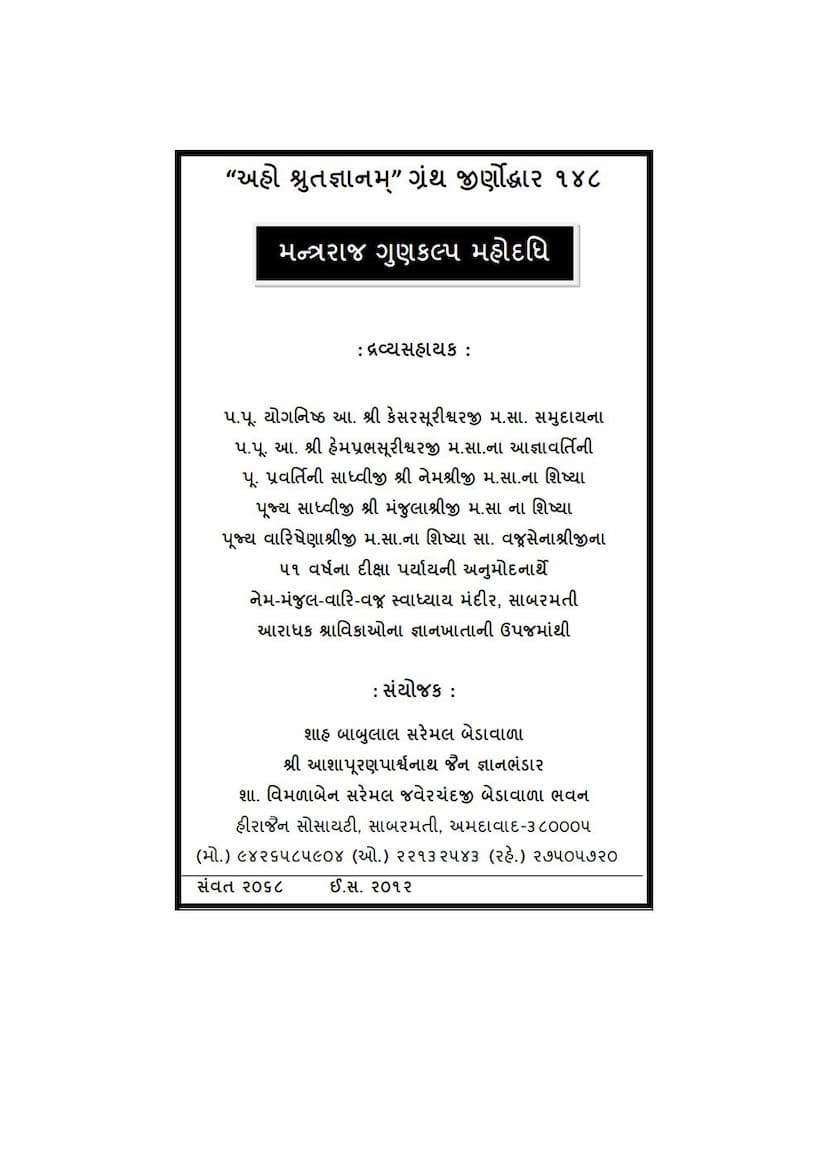Mantraraj Guna Kalpa Mahodadhi
Added to library: September 2, 2025

Summary
This document is a detailed, multi-volume work titled "Mantraraj Guna Kalpa Mahodadhi" (मंत्रराज गुण कल्प महोदधि) authored by Jinkirtisuri (जिनकीर्तिसूरि) and Jaydayal Sharma (जयदयाल शर्मा), and published by Jaydayal Sharma. The catalog link provided points to a Jain text related to the "Aho Shrutgyanam" (अहो श्रुतज्ञानम्) project, which focuses on restoring and making accessible ancient Jain scriptures.
Based on the provided pages, which appear to be the introductory and table of contents sections of this work, here's a comprehensive summary in English:
Title: Mantraraj Guna Kalpa Mahodadhi (मंत्रराज गुण कल्प महोदधि) Subtitle: Sri Panch Parmeshthi Namaskar Stotra Vyakhya (श्री पञ्चपरमेष्ठि नमस्कार स्तोत्र व्याख्या) - Commentary on the Stotra of the Five Supreme Beings. Author(s): Jinkirtisuri (जिनकीर्तिसूरि), Jaydayal Sharma (जयदयाल शर्मा) Publisher: Jaydayal Sharma Core Subject: This work is a detailed commentary and elaboration on the "Panch Parmeshthi Namaskar Stotra," more commonly known as the Navkar Mantra, which is the most revered mantra in Jainism.
Overall Scope and Content:
The book delves into the profound significance and multifaceted aspects of the Navkar Mantra. It appears to be an extensive compilation that not only explains the mantra itself but also encompasses related philosophical, ritualistic, and practical aspects of Jainism. The table of contents (indicated by the extensive list of chapter titles and their page numbers) reveals a comprehensive approach to understanding this fundamental Jain scripture.
Key Themes and Sections:
-
Introduction and Commendation: The initial pages include dedications, acknowledgments (like financial support for digitizing ancient texts), and introductory remarks praising the value of Shruta Jnana (knowledge gained through scripture). The work is presented as a valuable resource for spiritual and scholarly pursuit.
-
The Navkar Mantra and its Significance: The central focus is the Navkar Mantra. The book explores its importance, its efficacy in various spiritual and even material contexts (as suggested by the mention of various "mantras" for protection, prosperity, etc., in later sections), and its role in the spiritual journey.
-
Detailed Explanation and Commentary: The bulk of the work consists of a detailed commentary on the Navkar Mantra and its associated Stotra by Jinkirtisuri. This commentary is further elaborated and explained by Jaydayal Sharma.
-
Elaboration on Each Parmeshthi: The text appears to dedicate significant sections to each of the five supreme beings (Parmeshthis) – Arihant, Siddha, Acharya, Upadhyaya, and Sadhu – explaining their qualities, the significance of their names, and the philosophical underpinnings of revering them.
-
Mathematical and Structural Analysis: The "First Chapter" (प्रथम परिच्छेद) seems to focus on a mathematical and combinatorial analysis of the mantra. It discusses concepts like "prastar" (प्रस्तार - arrangement), "bhangasankhya" (भंगसंख्या - permutation count), "nashta" (नष्ट - finding the serial number of a given permutation), and "uddhishta" (उद्दिष्ट - finding the permutation itself). This suggests a scholarly and analytical approach to the mantra's structure, possibly exploring its potential for generating various permutations and their significance.
-
Yoga and Meditation Practices: The "Third Chapter" (तृतीय परिच्छेद) explicitly draws from Acharya Hemachandra's "Yoga Shastra" to describe various yogic practices, including:
- Dhyana (Meditation): Different types of meditation like Dharmadhyana (धर्मध्यान) and Shukladhyana (शुक्लध्यान).
- Asanas (Postures): Descriptions of various yogic postures like Padmasana, Virasana, Vajrasana, etc., important for meditation.
- Pranayama (Breath Control): Detailed explanations of Pranayama techniques (Rechaka, Puraka, Kumbhaka) and their physiological and spiritual benefits, including the role of specific "bija mantras" (बीज मंत्र) associated with different vital breaths (vayus).
- Internal Practices: Concepts like controlling the mind, stabilizing it, and understanding the subtle energies and channels within the body (nadis).
- Spiritual States: Descriptions of achieving mental stillness, spiritual bliss, and ultimately liberation.
-
Mantras for Various Purposes: The "Fourth Chapter" (चतुर्थ परिच्छेद) focuses on practical applications, presenting a collection of mantras, possibly derived from the "Namaskar Kalpa" (नमस्कार कल्प) and other sources. These mantras are presented for:
- Protection (Maha Raksha, Indrakavacha).
- Removal of obstacles and enemies.
- Curing ailments (fever, wounds).
- Attaining prosperity and fulfilling desires.
- General well-being and auspiciousness.
-
Q&A Format: The "Fifth Chapter" (पञ्चम परिच्छेद) adopts a question-and-answer format to address various nuances and interpretations related to the Navkar Mantra, such as:
- The meaning and etymology of "Parmeshthi" and the Navkar Mantra's nine constituent words.
- Grammatical aspects and variations in pronunciation/spelling.
- The significance of the order of the Parmeshthis.
- The meaning of "Mangalam" and its centrality.
- The total count of letters in the mantra (68) and its significance.
- The concept of "Siddhis" (supernatural powers) associated with the mantra.
-
The Eight Siddhis: The "Sixth Chapter" (षष्ठ परिच्छेद) specifically details the eight principal Siddhis (Siddhis) – anima, mahima, garima, laghima, prapti, prakamya, ishita, and vashitva – and their connection to the specific syllables or words within the Navkar Mantra. It explains the potential benefits and yogic practices associated with invoking these powers.
-
Dedication and Support: The initial pages highlight the support received for the "Aho Shrutgyanam" project, mentioning individuals and communities contributing to the preservation and digitization of these valuable texts.
Overall Significance:
"Mantraraj Guna Kalpa Mahodadhi" is presented as a monumental work that not only offers a deep spiritual and philosophical understanding of the Navkar Mantra but also provides practical guidance for its recitation and application. It bridges the gap between scholarly analysis, yogic practice, and devotional recitation, making it a valuable resource for Jain scholars, practitioners, and anyone interested in the rich spiritual heritage of Jainism. The meticulous detail in the table of contents suggests a thorough and authoritative treatment of the subject matter.